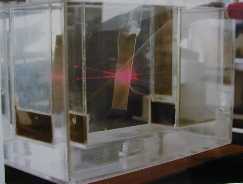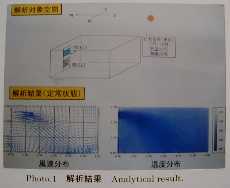■RESEARCH THEME
(1) Mixing
(2) Two Phase Flow
(3) CFD
(4) Property
(5) Distillation
(1)Mixing
Development and Evaluation of New Type Mixing Vessel
Wire Gauze Impeller
To improve the mass transfer for gas-liquid systems,a
wire gauze impeller has been developed. This impeller
prevents the gas cavity from foaming, and depresses the
power loss to a minimum. The mesh of the impeller makes
bubbles much smaller, and improves the gas dispersion.

EGSTAR
"EGSTAR" is an entrapped gel stirring tank reactor, developed
by Ohishi. This agitator has been practically used
as a bioreactor. It has a draft tube with punched holes
and double pitched paddles on the top and the bottom of
the draft tube .The fluid is drawn into the draft tube by
the double pitched paddles, and discharged through holes
on the draft tube.

Bottom buffle on mixing vessel
The radial bottom buffle raises the Ekman boundary layer
and a rising flow from the vessel bottom to the liquid free
surface.

Hydrodynamics in Mixing Vessel and Baffle Condition
What is Buffle?
As shown in photo.1, the central solid body region and the surface vortex are not good for mixing operations. These problems are resolved by installing baffles on the vessel wall, because the secondary flow develops in the vessel.

Short Baffle
An existing tank is often used for new manufacturing processes. We introduce short baffles into these devices to improve the tank. However, nothing is fonund for the short baffle. We have investigated the most suitable condition of the short baffle.

Scale up
It is important to scale up a laboratory mixing vessel to a pilot or a industry tank while maintaining the efficeincy of the device. However, there is no general way for the scale up. We have investigated the scale up with power consumption as a index for mixing operation.

(2) Two Phase Flow
Transport phenomena near an electrode immersed in bubble flow
In electrochemical industry, which consumes electric power very much, informations of bubble flow are needed to design an effective electolic cell.In this study the bubble flow near electrode, which affects mass transfer on the electrode surface,is investigated experimentally.
For the bubble flow of hydrogen or oxygen gas which is evolved from nickel electrode in a potassium hydroxide aqueous solution cell, both bubble and liquid velocity distributions near the electrode surface are measured with LDV(Laser Doppler Velocimeter).

(3)CFD
Numerical analysis of the flow of viscoelastic fluids
Interest in non-Newtonian fluids has increased
greatly in recent years. Problems, in particular,
involving flows of viscoelastic fluids, frequently
arise nowadays not only in polymer processing but also
in the diversed flieds of industries. It is also well
known that viscoelastic fluids, becacse of their elasticity,
exhibit complicated and unusual flow behaviours.
The main aim of this study is to develop a numeriacal method
for solving such flow problems related to viscoelasticity.
First of all, the swell phenomena of the flow at the exit of
an opening tube has been numerically simulated based on
viscoelastic constitutive equations of both Maxwell and
Oldroyd B model fluids by using Finite Element Method,
and then the computing program has been extended to
the flow through an abrupt expansion. The experiments of die swell
are also performed to verify the validity of the calculated results.

Numerical Simulation of Flow Pattern in an Equipment
1.Evaluation of air condition effect by numerical analysis of blow of air conditioner.
We have been developed an analysis program of "3D isotherm turbulent flow" used "k - εmodel", and simulated "air conditioning effect" is studied with this numerical analysis.

2.Evaluation of flow pattern in an Agitated vessel
We analyze in cylindrical vessel with double stage paddle impeller using
SOLA method.

3.Evaluation of effect of natural convection on FTIR-PBD by numerical simulation
FTIR-PBD (photothermal Beam Deflection) is one of surface analysis. Modulate infrared bean is irradiated on a sample submerged in a fluid and is absorbed in the sample surface. The IR energy in some frequency range is absorbed by the functional groups on the surface and the remained is changed into heat energy, which is conducted back to the fluid and changes the refractive index of the fluid. A probe laser passes just over the sample surface in horizontal direction and the beam deflection identifies the functional group.
We have evaluated the effect of the natural convection in the fluid on deflection of prove laser by numerical simulation. (SIMPLER method SOLA method)
Analysis of Nonlinear Phenomena for Chemical Processes
In recent years,many works for nonlinear phenomena have been
done. We have investigated the nonlinear phenomena for the
chemical reaction and the flow in reactors. The behavior of the
system can be expressed by nonlinear equations and can be solved
numerically. We have made clear the nonlinear characteristics of the
behavior solution, for example the irregularity and the sensitivity to
the initial conditions and the parameters.
・We have analyzed irregular change in reactant concentrations
of B-Z reaction in a CSTR with combined CSTRs models.

・We have analyzed long time fluctuation of the flow pattern and
torque in an agitated vessel.

Theoretical Analysis of Turbulent Flow and Heat
Transfer around Turbulence Promoters
Heat trasfer enhancement has long been an important engineering
subject; and many experimental works have been reported. One of the
method to improve heat transfer surface rate is to attach turbulence
promoters to heat transfer surface and to disturbe the fluid flow
in the vicinity of the surface. Teoretical studies on such a phenomena
involving turbulent flow, however, is hardly found, may be because
conventional model can not deal with the turbulent flow near the
wall of complex geometry where separation and reattachment of the
flow often occur. In this study, a simple turbulent model is developed
based on the cases where turbulent promoters are attached in a
constant interval to the heat transfer surface, the complex flow and
heat transfer around promoters are numerically analized by finite
element method, and the results are discussed in details from view
point of heat transfer enhancement.
(4) Property
Properties Predection of Molten salt Based on the Low of Corresponding States
Molten salt is defined as ionic liquid of inorganic salt at high the tempereture. It is one of the most useful media for reaction and energy transport and storage at the high tempereture. Molten salt mixtures are usefully used and it is difficult to obtain the properties of all the mixtures experimentally. It is desired to establish a useful method to estimate them theoretically.
We estimate the enthaply, molar volume, vapor pressure, surface tension, electrical conductivity, viscosity, and thermal conductivity with characteristic length and characteristic potential parameters based on the low of crresponding states from statical thermodynamics.
We have tried to estimate the mixing properties introducing perturbation terms with respect to the ionic size, valence, and mass.

(5) Distillation
Distillation Experiments
Operational characteristics of a packed distillation column
In recent years we gradually recognize the advantage of structured
packings, and plate columns are being replaced by packed columns. We
investigate the detailed characteristics of packing and the dynamic
behavior of the packed distillation column using a pilotscale column.
The equipment consists of a column with 20 cm in diameter and 3 m in
height and a still with 300 l in capacity. It has six control loops
of flow rates, liquid levels, pressures, and temperatures, and nine
temperature measuring points, which are monitored and controlled
intensively by UCS3000 of Yamatake-Honeywell Co.Inc.


Plate column distillation experiments
We make experiments using an Oldershaw plate column and analyze the
results by an equilibrium stage model and a rate based model and
reveal the relationship between these two models.
Selective drying of powder containing water and organic solvent
In the production process of powder such as food and
medicine, they are often purified by crystallization in
an organic solvent after the reaction process.
The organic solvent included in the powder can be removed
effectively using a maderately humidified drying air.
This process occurred due to selection diffusion between
water and organic solvent molecules.
We try to verify this mechanism by experiment and to
analyze its drying process by modeling indicated in Figure 1 and Figure 2.
Avarege concentration ratio C and particle surface
condition can be expressed by Eqs.(1) and (2).

Simulation of Distillation Processes
We have been developing simulation algorithms for various
distillation operations using successive relaxation
methods based on a equilibrium-stage model and a rate based model.
The equilibrium-stage model assumes liquid and vapor leaving
a stage are in equilibrium. Its schematic illustration is shown in Figure 1.
The rate-based model considers heat and mass transfer
rate between bulk vapor and liquid phases based on two film theory.
Its schematic is shown in Figure 2.
・Continuous and Batch Distillation
・Continuous and Batch Extractive Distillation
・Continuous and Batch Reactive Distillation
・Liquid-Liquid Extraction
・Absorption
The calculation results using the equilibrium stage model
and the rate based model, are compared with the experimental
result using a pilot scale packed column, and only calculation
result for Batch distillation.

















